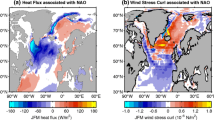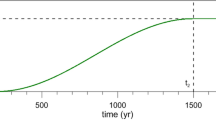Abstract
The correct mathematical approach to climate change requires the knowledge of the time-dependent system’s pullback/snapshot attractor (PBA). Once the governing equations and external forcing are known, the PBA can be estimated by performing an ensemble simulation (ES) of many forward time integrations differing only by their respective initialization; the resulting ensemble mean and spread are usually considered as representative of the forced and internal variability (FV and IV), respectively. In this paper the PBA of an excitable conceptual ocean model subjected to an idealized decadal time-scale aperiodic forcing is determined and is then used to show that the system’s relaxation oscillations contribute substantially to the ensemble mean, despite their intrinsic nature: as a consequence, a clear separation between the FV and IV is impossible in this case study. This provides an example of dynamical behaviour which may be typical of climate ESs under fluctuating aperiodic forcing. The impact of the number of ensemble members N on the statistical significance of the ES is then investigated. The complexity of realistic climate modelling currently imposes N = O(100): how significant is the statistical information derived from such small ESs? To answer this question for the present case study, the knowledge of the PBA is exploited to carry out a systematic comparison between the latter and small ESs with N = 50, also by using novel quantifiers specifically conceived for this purpose. The results reveal a remarkable significance of such ESs beyond the predictability time and may provide useful information for the design of future realistic ESs.

















Similar content being viewed by others
References
Ghil, M., Chekroun, M.D., Simonnet, E.: Climate dynamics and fluid mechanics: natural variability and related uncertainties. Physica D 237, 2111–2126 (2008)
Pierrehumbert, R.T.: Principles of Planetary Climate. Cambridge University Press, Cambridge (2010)
Chekroun, M.D., Simonnet, E., Ghil, M.: Stochastic climate dynamics: Random attractors and time-dependent invariant measures. Physica D 240, 1685–1700 (2011)
Bódai, T., Károlyi, G., Tél, T.: A chaotically driven model climate: extreme events and snapshot attractors. Nonlinear. Process. Geophys. 18, 573–580 (2011)
Bódai, T., Károlyi, G., Tél, T.: Fractal snapshot components in chaos induced by strong noise. Phys. Rev. 83E, 046201 (2011)
Bódai, T., Tél, T.: Annual variability in a conceptual climate model: snapshot attractors, hysteresis in extreme events, and climate sensitivity. Chaos 22, 023110 (2012)
Ghil, M.: The complex physics of climate change and climate sensitivity: a grand unification (Alfred Wegener Medal Lecture). European Geosciences Union General Assembly 2012, Vienna, Austria, European Geosciences Union, EGU2012-14438-1 (2012)
Ghil, M.: A mathematical theory of climate sensitivity or, how to deal with both anthropogenic forcing and natural variability? In: Chang, C.-P., Ghil, M., Latif, M., Wallace, J. (eds.) Climate Change: Multidecadal and Beyond, vol. 6, pp. 31–52. World Scientific Publishing Co., Singapore (2015)
Daron, J.D., Stainforth, D.A.: On quantifying the climate of the nonautonomous Lorenz-63 model. Chaos 25, 043103 (2015)
Drótos, G., Bódai, T., Tél, T.: Probabilistic concepts in a changing climate: a snapshot attractor picture. J. Clim. 28, 3275–3288 (2015)
Drótos, G., Bódai, T., Tél, T.: On the importance of the convergence to climate attractors. Eur. Phys. J. Spec. Top. 226, 2031–2038 (2017)
Ragone, F., Lucarini, V., Lunkeit, F.: A new framework for climate sensitivity and prediction: a modelling perspective. Clim. Dyn. 46, 1459–1471 (2016)
Herein, M., Márfy, J., Drótos, G., Tél, T.: Probabilistic concepts in intermediate-complexity climate models: a snapshot attractor picture. J. Clim. 29, 259–272 (2016)
Pierini, S., Ghil, M., Chekroun, M.D.: Exploring the pullback attractors of a low-order quasigeostrophic ocean model: the deterministic case. J. Clim. 29, 4185–4202 (2016)
Herein, M., Drótos, G., Haszpra, T., Márfy, J., Tél, T.: The theory of parallel climate realizations as a new framework for teleconnection analysis. Sci. Rep. 7, 44529 (2017)
Ghil, M.: A century of nonlinearity in the geosciences. Earth Space Sci. 6, 1007–1042 (2019)
Stocker, T.F., et al. (eds.): Climate Change 2013 (IPCC): The Physical Science Basis. Cambridge University Press, Cambridge (2013)
Drótos, G., Bódai, T., Tél, T.: Quantifying nonergodicity in nonautonomous dissipative dynamical systems: an application to climate change. Phys. Rev. E. 94, 022214 (2016)
Eckmann, J.-P., Ruelle, D.: Ergodic theory of chaos and strange attractors. Rev. Mod. Phys. 57, 617–656 (1985)
Nicolis, G.: Introduction to Nonlinear Science. Cambridge University Press, Cambridge (1995)
Ott, E.: Chaos in Dynamical Systems. Cambridge University Press, Cambridge (2002)
Tél, T., Gruiz, M.: Chaotic Dynamics. Cambridge University Press, Cambridge (2006)
Strogatz, S.H.: Nonlinear Dynamics and Chaos: with Applications to Physics, Biology, Chemistry, and Engineering. CRC Press, Boca Raton (2015)
Dijkstra, H.A., Ghil, M.: Low-frequency variability of the large-scale ocean circulation: a dynamical systems approach. Rev. Geophys. 43, 3002 (2005)
Ghil, M.: The wind-driven ocean circulation: applying dynamical systems theory to a climate problem. Discret. Contin. Dyn. Syst. A 37, 189–228 (2017)
Pierini, S.: Low-frequency variability, coherence resonance and phase selection in a low-order model of the wind-driven ocean circulation. J. Phys. Oceanogr. 41, 1585–1604 (2011)
Pierini, S., Chekroun, M.D., Ghil, M.: The onset of chaos in nonautonomous dissipative dynamical systems: a low-order ocean–model case study. Nonlinear. Process. Geophys. 25, 671–692 (2018)
Pikovsky, A.S., Kurths, J.: Coherence resonance in noise-driven excitable systems. Phys. Rev. Lett. 78, 775–778 (1997)
Pierini, S.: Coherence resonance in a double-gyre model of the Kuroshio Extension. J. Phys. Oceanogr. 40, 238–248 (2010)
Crucifix, M.: Oscillators and relaxation phenomena in Pleistocene climate theory. Phil. Trans. R. Soc. A370, 1140–1165 (2012)
Van der Pol, B.: On relaxation-oscillations. The London, Edinburgh and Dublin. Philos. Mag. J. Sci. 2, 978–992 (1926)
Bessières, L., Leroux, S., Brankart, J.-M., Molines, J.-M., Moine, M.-P., Bouttier, P.-A., Penduff, T., Terray, L., Barnier, B., Sérazin, G.: Development of a probabilistic ocean modelling system based on NEMO 3.5: application at eddying resolution. Geosci. Model Dev. 10, 1091–1106 (2017)
Maher, N., Milinski, S., Suarez-Gutierrez, L., Botzet, M., Dobrynin, M., Kornblueh, L., Kröger, J., Takano, Y., Ghosh, R., Hedemann, C., Li, C., Li, H., Manzini, E., Notz, D., Putrasahan, D., Boysen, L., Claussen, M., Ilyina, T., Olonscheck, D., Raddatz, T., Stevens, B., Marotzke, J.: The Max Planck Institute grand ensemble: enabling the exploration of climate system variability. J. Adv. Mod. Earth Syst. (2019). https://doi.org/10.1029/2019MS001639
Pierini, S.: A Kuroshio Extension system model study: decadal chaotic self-sustained oscillations. J. Phys. Oceanogr. 36, 1605–1625 (2006)
Pierini, S.: On the crucial role of basin geometry in double-gyre models of the Kuroshio Extension. J. Phys. Oceanogr. 38, 1327–1333 (2008)
Pierini, S., Dijkstra, H.A.: Low-frequency variability of the Kuroshio Extension. Nonlinear. Process. Geophys. 16, 665–675 (2009)
Pierini, S.: Stochastic tipping points in climate dynamics. Phys. Rev. E 85, 027101 (2012)
Pierini, S.: Ensemble simulations and pullback attractors of a periodically forced double-gyre system. J. Phys. Oceanogr. 44, 3245–3254 (2014)
Vannitsem, S., De Cruz, L.: A 24-variable low-order coupled ocean–atmosphere model: OA-QG-WS v2. Geosci. Model Dev. 7, 649–662 (2014)
De Cruz, L., Schubert, S., Demaeyer, J., Lucarini, V., Vannitsem, S.: Exploring the Lyapunov instability properties of high-dimensional atmospheric and climate models. Nonlinear. Process. Geophys. 25, 387–412 (2018)
Vallis, G.K.: Atmospheric and Oceanic Fluid Dynamics. Cambridge University Press, Cambridge (2006)
Arnold, L.: Random Dynamical Systems. Springer, New York (1998)
Rasmussen, M.: Attractivity and Bifurcation for Nonautonomous Dynamical Systems. Springer, New York (2007)
Bódai, T., Károlyi, G., Tél, T.: Driving a conceptual model climate by different processes: Snapshot attractors and extreme events. Phys. Rev. E 87, 022822 (2013)
Sérazin, G., Jaymond, A., Leroux, S., Penduff, T., Bessières, L., Llovel, W., Barnier, B., Molines, J.-M., Terray, L.: A global probabilistic study of the ocean heat content low-frequency variability: atmospheric forcing versus oceanic chaos. Geophys. Res. Lett. 44, 5580–5589 (2017)
Penduff, T., Barnier, B., Terray, L., Sérazin, G., Gregorio, S., Brankart, J.-M., Moine, M.-P., Molines, J.-M., Brasseur, P.: Ensembles of eddying ocean simulations for climate. CLIVAR Exchanges No. 65, Vol. 19, No. 2 (2014)
Leroux, S., Penduff, T., Bessières, L., Molines, J.-M., Brankart, J.-M., Sérazin, G., Barnier, B., Terray, L.: Intrinsic and atmospherically forced variability of the AMOC: insights from a large-ensemble ocean hindcast. J. Clim. 31, 1183–1203 (2018)
Pikovsky, A., Rosenblum, M., Kurths, J.: Synchronization: A Universal Concept in Nonlinear Sciences. Cambridge Nonlinear Science Series 12. Cambridge University Press, Cambridge (2003)
Shannon, C.E.: The mathematical theory of communication. Bell Syst. Technol. J. 27, 379–423 (1948)
Vissio, G., Lucarini, V.: Evaluating a stochastic parametrization for a fast–slow system using the Wasserstein distance. Nonlinear. Process. Geophys. 25, 413–427 (2018)
Acknowledgements
This work was funded by the MOMA (PNRA16_00196) and IPSODES (PNRA18_00199-C) projects of the Italian “Programma Nazionale di Ricerche in Antartide”. Support from the University of Naples Parthenope (Contract No. DSTE315B) is also kindly acknowledged.
Author information
Authors and Affiliations
Corresponding author
Additional information
Communicated by Valerio Lucarini.
Publisher's Note
Springer Nature remains neutral with regard to jurisdictional claims in published maps and institutional affiliations.
Rights and permissions
About this article
Cite this article
Pierini, S. Statistical Significance of Small Ensembles of Simulations and Detection of the Internal Climate Variability: An Excitable Ocean System Case Study. J Stat Phys 179, 1475–1495 (2020). https://doi.org/10.1007/s10955-019-02409-x
Received:
Accepted:
Published:
Issue Date:
DOI: https://doi.org/10.1007/s10955-019-02409-x




